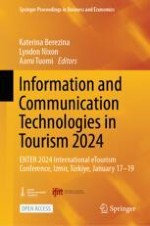Social media has significantly transformed the way people interact and communicate with each other [
5]. Social media can be seen as an extension of Web 2.0 concepts and technologies, facilitating the creation and distribution of user-generated content [
5]. Traditional social media plays its part in the pre-travel, during-travel and post-travel stages of the traveler’s journey [
6]. For example, when travelers make pre-trip decisions, online information search channels consist of search engines such as Google, independent websites of tourism stakeholders, OTA websites such as Ctrip and travel user generated content (UGC) platforms such as TripAdvisor [
6]. During and after the trip, individuals share their experiences through social media in the form of pictures and text descriptions [
7].
Driven by 5G technology, travelers are beginning to flock to new media platforms that are more vivid, instant, shared and interactive, such as short video platforms and tourism live streaming platforms [
8]. Tourism live streaming accompanies travelers throughout their whole travelling experience with its timely dissemination and real-time interaction [
9]. The unanticipated pandemic became a booster for the growth of live streaming in the tourism industry [
1]. Live streaming bridges the gap between on-the-go travelers and their family members and friends who are still quarantine at home to deliver virtual travel experiences in real time [
3]. The unique and immersive scene in live streaming allows even non-travelers to follow the camera changes from the first-angle of view, as if they were visiting the destination themselves [
4]. The subject of tourism live streaming is also becoming abundant, including but not limited to ordinary residents, tourists, key opinion leaders, tour guides, travel agencies, online travel companies and tourism destination governments. In response to the motivation and intention to share travel experiences in the form of texts and photos on social media, scholars have conducted studies using various theories, such as theory of reasoned action [
10], self-determination theory [
11], social influence theory [
7], flow theory [
12] and interaction ritual chain theory [
9]. Existing research has been started shifting the focus from social media in general towards live streaming. The research is mainly concerned with three aspects of live streaming, live streamers and viewers. In terms of live streaming, existing research has mainly discussed the definition [
4], characteristics [
12], types [
13], and stakeholders of live streaming [
3]. In terms of viewers, scholars have mainly examined viewers’ stickiness of live streaming platforms [
12], motivations to watch [
14] and shop [
15], the influence of tourism live streaming on viewers’ travel intention [
16], psychological well-being [
17] and trust and incentives of e-commerce live streaming platforms [
18]. For live streamers, related studies have discussed the definition [
2], motivations of live streamers [
19], and sustainability of live streamers [
20]. In the tourism sector, research on understanding the live streamers is still in its infancy. As a representative real-time value co-creation activity, the specific process of tourism live streaming has not yet been fully revealed. Hence, the motivation of live-streamers to engage in tourism live-streaming activities and the process of customer-to-customer real-time value co-creation in tourism live streaming needs to be studied.
